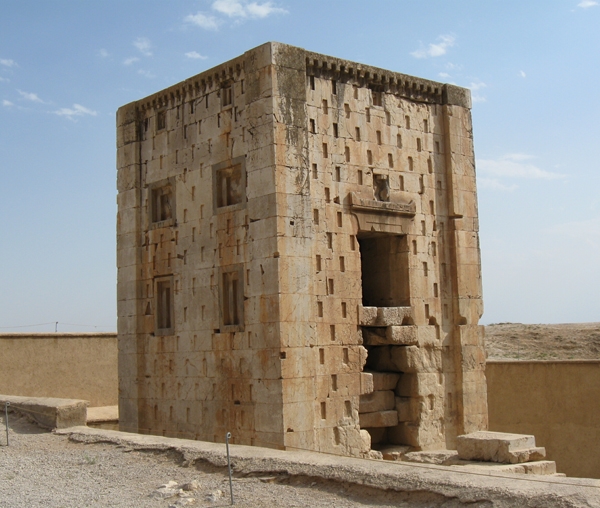Ka’ba-ye Zartosht is the name of a stone quadrangular and stepped structure in the Naqsh-e Rustam compound beside Zangiabad village in Marvdasht county in Fars, Iran. The Naqsh-e Rustam compound incorporates memorials of the Elamites, the Achaemenids and the Sassanians in itself in addition to the mentioned structure.
The Ka’ba-ye Zartosht is from the mountain, situated exactly opposite Darius II’s mausoleum. It is rectangular and has only one entrance door. The material of the structure is white limestone. Its entrance door leads to the chamber inside via a thirty-stair stone stairway. The stone pieces are rectangular and are simply placed on top of each other, without the use of mortar; they are connected to each other by dovetail joints. The structure was built in the Achaemenid era and there is no information of the name of the structure in that era. It was called Bon-Khanak in the Sassanian era; the local name of the structure was Kornaykhaneh or Naggarekhaneh; and the phrase Ka’ba-ye Zartosht has been used for the structure since the fourteenth century, into the contemporary era.
Various views and interpretations have been proposed about the application of the chamber, but none of them could be accepted with certainty: some consider the tower a fire temple and a fireplace, and believe that it was used for igniting and worshiping the holy fire, while another group rejects this view and considers it the mausoleum of one of the Achaemenid shahs or grandees, due to its similarity to the Tomb of Cyrus and some mausoleums of Lycia and Caria. Some other Iranian scholars believe the stone chamber to be a structure for the safekeeping of royal documents and holy or religious books; however, the chamber of Ka’ba-ye Zartosht is too small for this purpose. Other less noticed theories, such as its being a temple for the goddess Anahita or a solar calendar, have also been mentioned.
Three inscriptions have been written in the three languages Sassanian Middle Persian, Arsacid Middle Persian and Greek on the Northern, Southern and Eastern walls of the tower, in the Sassanian era. One of them belongs to Shapur I the Sassanian, and the other to the priest Kartir. According to Walter Henning, “These inscriptions are the most important historical documents from the Sassanian era.” The Ka’ba-ye Zartosht is a beautiful structure: its proportions, lines and external beauty are based on well-executed architectural principles.
Currently, the structure is part of the Naqsh-e Rustam compound and owned by the Cultural Heritage, Handicrafts and Tourism Organization of Iran.

Comment (0)